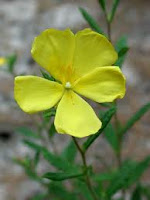The Californian poppy is a member of the Papavaraceae family making it a relative of the European red poppy and the opium poppy as well as the Greater Celandine and the Yellow Horned Poppy, but does not have the same properties as the opium poppy. As its name suggests it is native to California and other US states, and has the distinction of being the official state flower of the state from which it gets its name. It has its own day in that state in April and there is also a Californian poppy festival in the same month.
It gets its genus name from Adelbert von Chamissa who was the first to describe it in 1820. He named it after his friend, a physician and botanist, Johann Friedrich von Eschscholtz who was on the same expedition which landed in California in 1816.
The Native Americans used this plant mainly, it would seem, to stop a breast-feeding woman’s milk. This was done either by using poultices of the seeds pods and applying them to the breasts or by taking an extract of the roots and washing the breasts to suppress the milk.

The watery sap from the plant is mildly narcotic and was used to relieve the pain of toothache. The root was also chewed for toothache. The pollen from the poppies had cosmetic uses for some Native American tribes, and they used the seeds in cooking.
Today the leaves and stems, also the flowers sometimes are used to make a tisane which is supposed to relieve a tension headache and to induce sleep. This tisane is used to relieve stress in the same way as Eleuthero, Skullcap, rose root and American ginseng are used. The tisane may be made from the fresh or dried leaves.
 Research that has been conducted into the Californian poppy has been inconclusive; it may have mild pain-killing effects, but only in high doses. It does however contain the flavonoids quercetin, rutin and zeaxanthin, so the tisane would have good antioxidant properties.
Research that has been conducted into the Californian poppy has been inconclusive; it may have mild pain-killing effects, but only in high doses. It does however contain the flavonoids quercetin, rutin and zeaxanthin, so the tisane would have good antioxidant properties. The leaves are edible if cooked, although they have a bitter taste. To make the tisane take a handful of the fresh chopped plant and pour a cup of boiling water over it and leave it to steep for 10 minutes before straining and drinking. You can sweeten it with honey or mint leaves, if it is too bitter for your palate.

The plant is nyctinastic, meaning that its flowers will close at night and reopen in daylight and also they will close when it rains. In this way it is like the sensitive plant and wood sorrel.
The Californian poppy has been introduced to parts of Europe and is a garden escapee in Britain . It has also found the climate of South America and Australia to its liking.
Traditionally the Californian poppy has been used to prevent children bedwetting, and as a diuretic and to promote sweating in a fever.
You should only take medical preparations of this poppy, including the tisane, under close medical supervision of course.






























